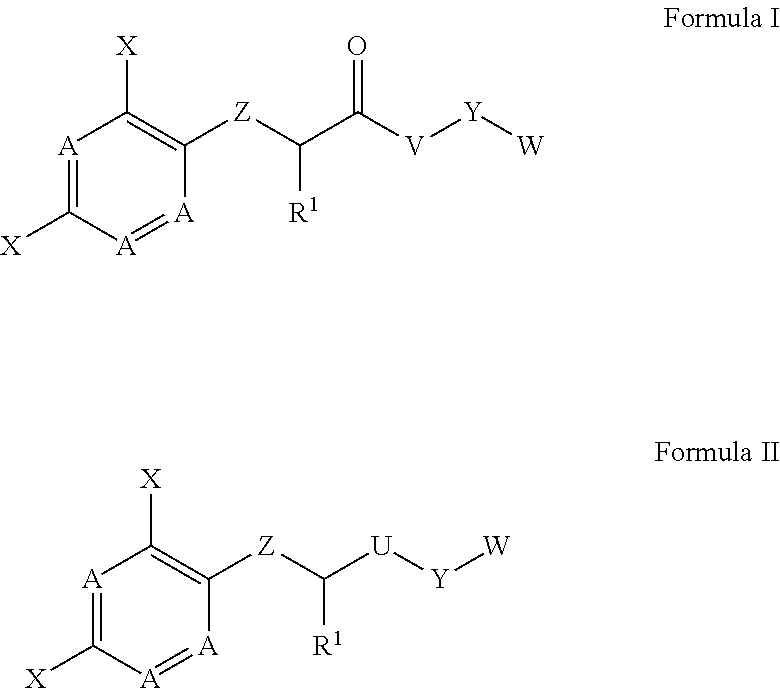Inhibitors of bacterial type iii secretion system
a secretion system and bacterial technology, applied in the field of therapeutic drugs to treat bacterial infection and disease, can solve problems such as local disruption of essentials, and achieve the effect of effectively killing infecting or contaminating bacteria
- Summary
- Abstract
- Description
- Claims
- Application Information
AI Technical Summary
Benefits of technology
Problems solved by technology
Method used
Image
Examples
example 1
Materials and Methods for Characterization of T3SS Inhibitors
Strains, Plasmids, and Growth Media.
[0122]Bacterial strains and plasmids used for assays are described in Table 2, below. All P. aeruginosa strains were derivatives of PAO1 (Holloway, et al., 1979, Microbiol. Rev., 43:73-102), PAK (Bradley, D. E., 1974, Virology, 58:149-63), or PA14 (Rahme, et al., 1995, Science, 268:1899-902). E. coli TOP10 (Invitrogen), E. coli DB3.1 (GATEWAY® host, Invitrogen), E. coli SM10 (de Lorenzo and Timmis, 1994, Methods Enzymol., 235:386-405), and E. coli S 17-1 (ATCC 47055) were used as hosts for molecular cloning. Luria-Bertani (LB) medium (liquid and agar) was purchased from Difco. LB was supplemented with 30 μg / ml gentamicin (LBG) with or without 1 mM isopropyl-β-D-thiogalactopyranoside (IPTG) and 5 mM EGTA (LBGI and LBGIE, respectively).
TABLE 2Strains and PlasmidsReferenceStrainGenotype / Featuresor SourceMDM852PA01::pGSV3-‘exoT’-luxCDABE(1)MDM1355PA01 ΔpscC::pGSV3-‘exoT’-luxCDABE(1)MDM973PAK...
example 2
Optimization and SAR Analysis
[0134]Several analogues of compound MBX-1641 were synthesized as described herein and their level of inhibition of T3SS-mediated secretion, translocation, and cytotoxicity determined. Details of the synthesis and physical properties of the following non-limiting examples are as follows:
4-fluorophenethyl 2-(2,4-dichlorophenoxy)propanoate (MBX-2717)
[0135]
To a solution of 2-(2,4-dichlorophenoxy)propionic acid (0.10 g, 0.43 mmol) in DMF (2 mL) was added a solution of 2-(1H-7-Azabenzotriazol-1-yl)-1,1,3,3-tetramethyl uronium hexafluorophosphate (0.19 g, 0.51 mmol, 1.2 eq) in dry DMF (2 mL), and diisopropylethylamine (0.1 mL, 0.5 mmol, 1.3 eq). The solution was stirred at room temperature for 5 min, then 2-(4-fluorophenyl)ethanol (64 mL, 0.51 mmol, 1.2 eq), was added and the solution was stirred at room temperature an additional 55 h. The reaction mixture was diluted with water (=25 mL) and the aqueous suspension was extracted with ethyl acetate 3×20 mL). The ...
example 3
Determination of Active and Inactive Isomers
[0195]The compounds of formula I have an asymmetric center (α carbon), and therefore the synthesis of these compounds can yield a mixture of optical isomers (racemic mixture), or either R- or S-isomers, depending on the method used for synthesis. The initial synthesis of MBX-1641 provided a racemic mixture. To determine whether both isomers contribute to the inhibitory properties of such compounds, the separate isomers of compound MBX-1641 were synthesized by treating dichlorophenol with the commercially available (S)-ethyl lactate (to yield the optically pure R-isomer of MBX-1641) or with commercially available (R)-ethyl lactate (to yield the optically pure S-isomer of MBX-1641). Reaction of the hydroxy group of the (S)-ethyl lactate with dichlorophenol under Mitsunobu conditions proceeds with inversion of configuration at the chiral center to provide the (R)-ester. Saponification of the ester, followed by peptide coupling, provides compo...
PUM
 Login to View More
Login to View More Abstract
Description
Claims
Application Information
 Login to View More
Login to View More - R&D
- Intellectual Property
- Life Sciences
- Materials
- Tech Scout
- Unparalleled Data Quality
- Higher Quality Content
- 60% Fewer Hallucinations
Browse by: Latest US Patents, China's latest patents, Technical Efficacy Thesaurus, Application Domain, Technology Topic, Popular Technical Reports.
© 2025 PatSnap. All rights reserved.Legal|Privacy policy|Modern Slavery Act Transparency Statement|Sitemap|About US| Contact US: help@patsnap.com



